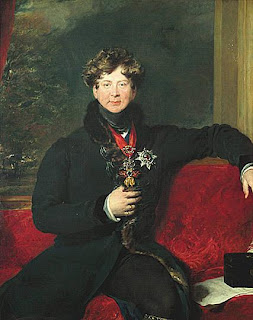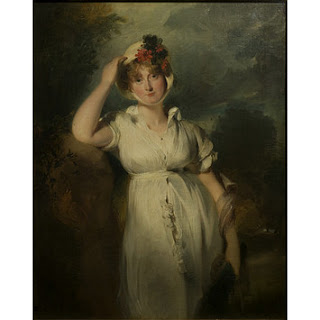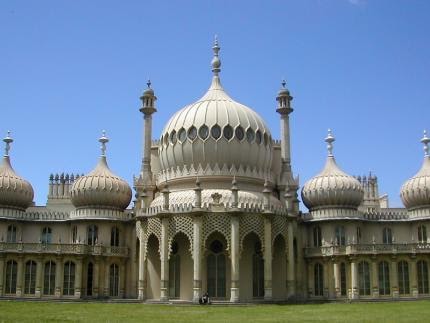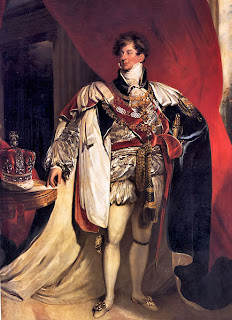
By February 5, 1811, both houses of Parliament had passed the Regency Act, making George, Prince of Wales, the Regent for his incapacitated father, George III, who was under doctors’ care at Windsor Castle. The Prince took the royal oath on February 6, 1811.
He was 48 years old. He had a legal wife, Princess Caroline, whom he despised, and from whom he had been estranged since shortly after the wedding. Their daughter, Princess Charlotte of Wales, was 15 years old, and suffered from the great inconsistencies in her father’s attention and attitude. She was most often ignored by him, but occasionally she was flaunted before the public, which adored her and loathed him.
 |
| Princess Charlotte by Richard Woodman, 1816, NPG |
 |
| Caroline, Princess of Wales by Sir Thomas Lawrence, 1798, VandA |
Caroline, by 1811, had set up a separate establishment where she entertained and socialized. Some of her behavior was reported to be scandalous, and her access to her daughter was often restricted. Caroline enjoyed — and often flaunted — her personal popularity with the people. She resented her position as a cast-aside wife with little or no access to court and none of the honors due her. Little wonder that there were constant rumors circulating in London society.
 |
| Mrs. Fitzherbert by Gainsborough, 1787 |
Prince George had another wife, Maria Fitzherbert, though the union was not legal according to the requirements of the laws regarding royal marriages. Maria put up with a lot of misbehavior from George too. He left her not only for a legal wife, however temporarily, but also had numerous mistresses while he was associating with her. Like Caroline, Maria loved children; both women adopted other children on whom they poured their maternal love. One hopes that all three of these women – Maria, Caroline and Charlotte – managed some degree of happiness in their lives as they were consistently disappointed by the whims and caprices of George, Prince of Wales.
Prince George resided at Carlton House in London, a building he had turned into a palace filled with magnificent art works and sumptuous furnishings. Typical of his over-indulgence in all matters, as King, George IV had Carlton House demolished in 1825 for a new plan to enhance the new Regent Street. Meanwhile, he turned his Marine Pavilion in Brighton, from the tasteful building completed by Henry Holland in 1787, below, into a fantastical building in which the interior is Chinese style while the exterior is Indian-Mughal, whatever that is. Rev. Sydney Smith remarked upon seeing the Pavilion, “It looks like St. Paul’s Cathedral came down and pupped.”
 |
| The Marine Pavilion, Brighton Henry Holland, Architect, 1787 Brighton Pavilion, as remodeled by John Nash, after 1811 |
But George never was very popular. Sometimes the press was full of praise, but between the essayists, satirists and artists of caricatures, the Regent took his full share of criticism.
Here is a fragment of the praiseful poem published by the Morning Post newspaper in honor of the new Prince Regent:
Adonis! In thy shape and face,
A liberal heart and Princely grace
In thee are seen combined …
But Leigh Hunt and his brother John, editor of a literary magazine called the Examiner, published a different view:
“… An Adonis of 50 … a violator of his word, a libertine over head and ears in debt and disgrace, a despiser of domestic ties, the companion of gamblers and demi-reps, a man without a single claim to the gratitude of his country or the respect of posterity …”
Though many hailed them as heroes for their position, the Hunts were sued for and convicted of libel and served time in jail. Among the visitors to Leigh Hunt in prison were the poet Lord Byron, Lord Brougham, and essayist Charles Lamb.
 |
| Leigh Hunt, essayist and critic, 1784-1859
“The Prince of Whales, or The Fisherman at Anchor: We will look at the Prince, or Prinny as many called him, and his reign many times in the upcoming months. It was a time of excess in many ways, and he certainly led the pack. We will see many more caricatures — they were in their glory in those days — and we will look at the real achievements of the Prince, particularly in assembling his collections of art and decorative arts. At his Pavilion in Brighton, a new exhibition is about to open: Dress for Excess, Fashion in Regency England. suitable title, don’t you agree? It will include the magnificent Coronation Robe worn by the Prince as he became George IV in 1921. Below, the King’s portrait by Sir Thomas Lawrence (who else?). |




Oh, great essay! Just wonderful. You touched on everything. This was the man my biographical subject, Grace Dalrymple Elliott, claimed was the father of her daughter, Georgiana. (The jury will be forever out on that one!)
Prinny loved Thomas Lawrence, who made him look so good in those portraits 🙂
Prince of Whales, yes, indeed, but Prince of Excess, even more apt.
Thomas Lawrence made everybody look good!
One of the curators of the Pavilion believed Prinny got a bad rap. She refused even to call him Prinny.
It is as if the man set out to make all of the women in his life equally miserable. In Arabic societies a man might have as many wives as he pleased, BUT he had to treat them all equally. Prinny succeeded at that at least. He treated the women in his life equally bad!
Spectacular essay!
Wonderful essay… For all "Prinny's" faults… and there were many, as the leading man of the Regency, he ushered in the principles of stylish interior design, delicious cuisine and graceful architecture… Brighton Pavillion excluded!!
I'm sure you know what the Indian-Mughal style is really, and are just being mischievous. As one who was brought up in Brighton and often returns there to enjoy that lovely seaside town, I admire the Royal Pavilion immensely.
Is its design excessive? If so, let's have a lot more excess please, as an antidote to the horrible, brutal structures that modern architects are inflicting on us and with which they are defacing our cities.
The sheer exuberance of the design is a wonder to behold and the beauty of the interior is breath-taking. I honestly think that anyone who fails to appreciate this splendid building is beyond hope.
You can, if you don't like "Indian-Mughal", refer to it as "orientalist" and a lot of orientalist design was used in Brighton (and no doubt other places) around that time. In Western Terrace, Brighton, is a house called the Western Pavilion. It was built in 1831 by Amon H. Wilds as his own house and looks like a Royal Pavilion in miniature. Would I like to live there? Do you need to ask?
You may know that during WWII, a rumour circulated that Hitler had determined that the Royal Pavilion was to be his residence when in England and that the Luftwaffe had been given the strictest orders not to bomb it. During air raids, people caught outside in nearby streets would run into the Pavilion grounds, believing they would be safe there. Possibly they were right, as the Pavilion emerged from the war unscathed, despite the horrendous damage done to other parts of Brighton.